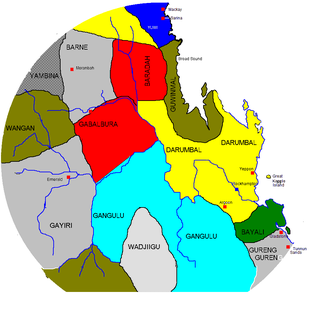
The Wakaya are an Aboriginal Australian people of the Northern Territory.

The Wakaya are an Aboriginal Australian people of the Northern Territory.
Norman Tindale's estimate of the Wakaya's territory assigns them some 15,000 square miles (39,000 km2). [1]
The Wakaya language is now extinct. [2]
The Wakaya were one of the Australian peoples, the others being the Watjarri, Wanman, Pitjantjatjara, Ngadadjara and Alyawarre, who are known to have harvested purslane seeds, and threshed them within stone circles for the oily nutrients they provided. [3]
In 1980 the Wakaya people lodged a land claim along with the Alyawarre people for land somewhere near the remote outstation of Purrukwarra. As a result, they were handed back 1,874 square kilometres (724 sq mi) on 22 October 1992, while the Alyawarre were given 2,065 square kilometres (797 sq mi), both of which were only small parts of the original claim. [4]
The Alyawarre, also spelt Alyawarr and also known as the Iliaura, are an Aboriginal Australian people, or language group, from the Northern Territory. The Alyawarre are made up of roughly 1,200 associated peoples and actively engage in local traditions such as awelye painting.
The Ramindjeri or Raminjeri people were an Aboriginal Australian people forming part of the Kukabrak grouping now otherwise known as the Ngarrindjeri people. They were the most westerly Ngarrindjeri, living in the area around Encounter Bay and Goolwa in southern South Australia, including Victor Harbor and Port Elliot. In modern native title actions a much more extensive territory has been claimed.
The Kurrama people, also known as the Puutu Kunti Kurrama people, are an Aboriginal Australian people from the Pilbara region of Western Australia.
The Bigambul people are an Aboriginal Australian people of the Northern Tablelands and Border Rivers regions of New South Wales and Queensland.
The Gurindji are an Aboriginal Australian people of northern Australia, 460 kilometres (290 mi) southwest of Katherine in the Northern Territory's Victoria River region.

Alpurrurulam, from the original Aboriginal name Ilperrelhelame, also known as Lake Nash, is a locality in the Northern Territory of Australia located in the territory's east about 1,206 kilometres (749 mi) south-east of the territory capital of Darwin and about 570.1 kilometres (354.2 mi) east of the municipal seat of Tennant Creek and about 17 kilometres (11 mi) from the border with the state of Queensland. The town is at the end of the Sandover Highway, which floods each year during the wet season and cuts all road access to the community.
The Gidabal, also known as Kitabal and Githabul, are an indigenous Australian tribe of southern Queensland, who inhabited an area in south-east Queensland and north-east New South Wales, now within the Southern Downs, Tenterfield and Kyogle Local Government regions.
The Warumungu are a group of Indigenous Australians of the Northern Territory. Modern day Warumungu are mainly concentrated in the region of Tennant Creek and Alice Springs.

The Gabulbarra people, also rendered Gabalbura, Gabalbara and Kabalbara, is an Aboriginal Australian people of an area in eastern Central Queensland, but there is little recorded information about them.
The Ngaiawang (Ngayawang) were an Aboriginal Australian people of the western Riverland area of South Australia, with a language considered part of the Lower Murray group. They are now considered extinct. They have sometimes been referred to as part of the Meru people, a larger grouping which could also include the Ngawait and Erawirung peoples. They were called Birta by the Kaurna and Ngadjuri peoples, variations of Murundi by the Jarildekald people, and were also known various other terms and spellings.
The Miriwoong people, also written Miriwung and Miriuwung, are an Aboriginal Australian people of the Kimberley region of northern Western Australia.
The Gajirrawoong people, also written Gadjerong, Gajerrong and other variations, are an Aboriginal Australian people of the Northern Territory, most of whom now live in north-eastern Western Australia.
The Kukatja people, also written Gugadja, are an Aboriginal Australian people of the Kimberley region of Western Australia.
The Ngardi, also spelled Ngarti, are an Aboriginal Australian people of the Northern Territory and Western Australia.
The Binigura people, these days usually spelt Pinikura, are an Aboriginal Australian people of the Pilbara region of Western Australia.
The Kareldi was a name assigned by Norman Tindale to Aboriginal Australian peoples of the state of Queensland. There were two groups that went by this name, the Garandi (Karandi), after the Garandi language, and the Gkuthaarn, after the Gkuthaarn language. It is not clear if they constituted a single people, but it appears that there were two dialects in the same area.
The Juru (Yuru) are an Aboriginal Australian people of the state of Queensland
The Kukatj are an Aboriginal Australian people of the Cape York Peninsula in the state of Queensland. They are to be distinguished from the Kukatja of Western Australia and the Luritja of the Northern Territory, who have also historically been known as Kukatja.
The Luritja or Loritja people, also known as Kukatja or Kukatja-Luritja, are an Aboriginal Australian people of the Northern Territory. Their traditional lands are immediately west of the Derwent River, that forms a frontier with the Arrernte people, with their lands covering some 27,000 square kilometres (10,300 sq mi). Their language is the Luritja dialect, a Western Desert language.
The Yarluyandi, also known as Jeljendi, are an Aboriginal Australian people of north-eastern South Australia.